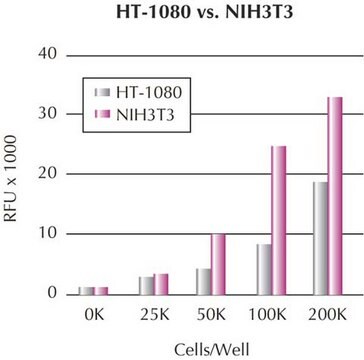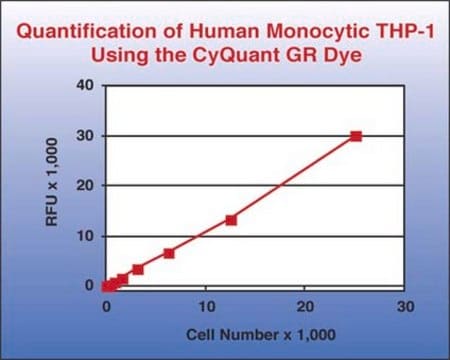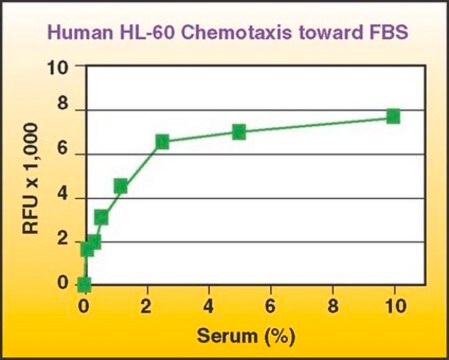ECM510
Ensayo de migración celular por quimiotaxis QCM, 96 pocillos (8 µm), fluorométrico
The QCM 8 uM 96-well Migration Assay utilizes a 8 um pore size, which is appropriate for leukocyte migration.
Sinónimos:
Fluorescent cell migration assay
Iniciar sesiónpara Ver la Fijación de precios por contrato y de la organización
About This Item
UNSPSC Code:
12352207
eCl@ss:
32161000
Productos recomendados
Quality Level
species reactivity (predicted by homology)
all
manufacturer/tradename
Chemicon®
QCM
technique(s)
activity assay: suitable
cell based assay: suitable
detection method
fluorometric
shipped in
wet ice
Categorías relacionadas
General description
Also available: Cell Comb™ Scratch Assay! Get biochemical data from a scratch assay!
Click Here
Introduction
Cell migration is a fundamental function of normal cellular processes, including embryonic development, angiogenesis, wound healing, immune response, and inflammation. Microporous membrane inserts are widely used for cell migration and invasion assays. The most widely accepted of which is the Boyden Chamber assay. However, current methods of analysis are time-consuming and tedious, involving cotton swabbing of non-migrated cells on the top side of insert, manual staining and counting. Recently a fluorescence blocking membrane insert was introduced to address these issues; however, this approach requires labeling of the cells with Calcein-AM and extensive washing to remove free Calcein before cell migration. The effect of this treatment on cell behavior/migration remains questionable.
The Chemicon QCM<TMSYMBOL></TMSYMBOL> 96-well Migration Assay does not require cell labeling, scraping, washing or counting. The 96-well insert and homogenous fluorescence detection format allows for large-scale screening and quantitative comparison of multiple samples.
In the Chemicon QCM<TMSYMBOL></TMSYMBOL> 96-well Migration Assay, migratory cells on the bottom of the insert membrane are dissociated from the membrane when incubated with Cell Detachment Buffer. These cells are subsequently lysed and detected by the patented CyQuant GR dye (Molecular Probes). This green-fluorescent dye exhibits strong fluorescence enhancement when bound to cellular nucleic acids.
The Chemicon QCM<TMSYMBOL></TMSYMBOL> 96-well Migration Assay provides a quick and efficient system for quantitative determination of various factors on cell migration, including screening of pharmacological agents, evaluation of integrins or other adhesion receptors responsible for cell migration, or analysis of gene function in transfected cells.
The Chemicon QCM<TMSYMBOL></TMSYMBOL> 96-well Migration Assay utilizes an 8 μm pore size, as this is appropriate for most cell types. This pore size supports optimal migration for most epithelial and fibroblast cells; however, it is not appropriate for lymphocyte migration experiments. The system may be adapted to study different types of cell migration, including haptotaxis, random migration, chemokinesis, and chemotaxis.
In addition, Chemicon also provides QCM<TMSYMBOL></TMSYMBOL> 24-well insert cell migration assay systems, CytoMatrix<TMSYMBOL></TMSYMBOL> Cell Adhesion strips coated with ECM proteins or anti integrin antibodies, and QuantiMatrix<TMSYMBOL></TMSYMBOL> ECM protein ELISA kits.
Application:
The Chemicon QCM<TMSYMBOL></TMSYMBOL> 96-well Migration Assay is ideal for the study of chemotaxis cell migration. The quantitative nature of this assay is especially useful for large scale screening of pharmacological agents. The 8 μm pore size of this assay′s Boyden chambers is appropriate for migration studies of most cell types. Each kit provides sufficient materials for the evaluation of 96 samples.
The Chemicon QCM<TMSYMBOL></TMSYMBOL> 96-well Migration Assay is intended for research use only; not for diagnostic applications.
Click Here
Introduction
Cell migration is a fundamental function of normal cellular processes, including embryonic development, angiogenesis, wound healing, immune response, and inflammation. Microporous membrane inserts are widely used for cell migration and invasion assays. The most widely accepted of which is the Boyden Chamber assay. However, current methods of analysis are time-consuming and tedious, involving cotton swabbing of non-migrated cells on the top side of insert, manual staining and counting. Recently a fluorescence blocking membrane insert was introduced to address these issues; however, this approach requires labeling of the cells with Calcein-AM and extensive washing to remove free Calcein before cell migration. The effect of this treatment on cell behavior/migration remains questionable.
The Chemicon QCM<TMSYMBOL></TMSYMBOL> 96-well Migration Assay does not require cell labeling, scraping, washing or counting. The 96-well insert and homogenous fluorescence detection format allows for large-scale screening and quantitative comparison of multiple samples.
In the Chemicon QCM<TMSYMBOL></TMSYMBOL> 96-well Migration Assay, migratory cells on the bottom of the insert membrane are dissociated from the membrane when incubated with Cell Detachment Buffer. These cells are subsequently lysed and detected by the patented CyQuant GR dye (Molecular Probes). This green-fluorescent dye exhibits strong fluorescence enhancement when bound to cellular nucleic acids.
The Chemicon QCM<TMSYMBOL></TMSYMBOL> 96-well Migration Assay provides a quick and efficient system for quantitative determination of various factors on cell migration, including screening of pharmacological agents, evaluation of integrins or other adhesion receptors responsible for cell migration, or analysis of gene function in transfected cells.
The Chemicon QCM<TMSYMBOL></TMSYMBOL> 96-well Migration Assay utilizes an 8 μm pore size, as this is appropriate for most cell types. This pore size supports optimal migration for most epithelial and fibroblast cells; however, it is not appropriate for lymphocyte migration experiments. The system may be adapted to study different types of cell migration, including haptotaxis, random migration, chemokinesis, and chemotaxis.
In addition, Chemicon also provides QCM<TMSYMBOL></TMSYMBOL> 24-well insert cell migration assay systems, CytoMatrix<TMSYMBOL></TMSYMBOL> Cell Adhesion strips coated with ECM proteins or anti integrin antibodies, and QuantiMatrix<TMSYMBOL></TMSYMBOL> ECM protein ELISA kits.
Application:
The Chemicon QCM<TMSYMBOL></TMSYMBOL> 96-well Migration Assay is ideal for the study of chemotaxis cell migration. The quantitative nature of this assay is especially useful for large scale screening of pharmacological agents. The 8 μm pore size of this assay′s Boyden chambers is appropriate for migration studies of most cell types. Each kit provides sufficient materials for the evaluation of 96 samples.
The Chemicon QCM<TMSYMBOL></TMSYMBOL> 96-well Migration Assay is intended for research use only; not for diagnostic applications.
Application
Categoría de investigación
Estructura celular
Estructura celular
El ensayo de migración de 96 pocillos 8 um QCM utiliza un tamaño de poro de 8 um, adecuado para la migración de leucocitos.
Packaging
96 pocillos
Components
Conjunto de placa de migración celular de 96 pocillos estéril: (Nº de ref. 90128) Una bandeja de alimentación de 96 pocillos y una placa de cámara de migración celular de 96 pocillos. Superficie = 0,3 cm2, 50 000 células por pocillo
Bandeja de cultivo celular de 96 pocillos: (Nº de ref. 90129) Una bandeja de alimentación de 96 pocillos.
Disolución de desprendimiento celular: (Nº de ref. 90131) Un frasco - 16 ml.
Tampón de lisis celular x4: (Nº de ref. 90130) Un frasco - 16 ml.
Colorante CyQuant GR: (Nº de ref. 90132) Un vial - 75 μl
Bandeja de cultivo celular de 96 pocillos: (Nº de ref. 90129) Una bandeja de alimentación de 96 pocillos.
Disolución de desprendimiento celular: (Nº de ref. 90131) Un frasco - 16 ml.
Tampón de lisis celular x4: (Nº de ref. 90130) Un frasco - 16 ml.
Colorante CyQuant GR: (Nº de ref. 90132) Un vial - 75 μl
Legal Information
CELL COMB is a trademark of Merck KGaA, Darmstadt, Germany
CHEMICON is a registered trademark of Merck KGaA, Darmstadt, Germany
Disclaimer
Salvo que se indique lo contrario en nuestro catálogo o en otra documentación de la empresa que acompañe al producto, nuestros productos están indicados sólo para investigación y no deben utilizarse para ningún otro propósito, como, entre otros, usos comerciales no autorizados, diagnóstico in vitro, usos terapéuticos ex vivo o in vivo o cualquier tipo de consumo o aplicación en humanos o animales.
signalword
Danger
hcodes
Hazard Classifications
Aquatic Acute 1 - Aquatic Chronic 2 - Eye Dam. 1
Storage Class
10 - Combustible liquids
wgk_germany
WGK 3
Certificados de análisis (COA)
Busque Certificados de análisis (COA) introduciendo el número de lote del producto. Los números de lote se encuentran en la etiqueta del producto después de las palabras «Lot» o «Batch»
¿Ya tiene este producto?
Encuentre la documentación para los productos que ha comprado recientemente en la Biblioteca de documentos.
Zhaolu Wang et al.
Journal of cerebral blood flow and metabolism : official journal of the International Society of Cerebral Blood Flow and Metabolism, 32(2), 387-398 (2011-11-03)
Ischemic stroke affecting the adult brain causes increased progenitor proliferation in the subventricular zone (SVZ) and generation of neuroblasts, which migrate into the damaged striatum and differentiate to mature neurons. Meteorin (METRN), a newly discovered neurotrophic factor, is highly expressed
Nadia K Guimaraes-Souza et al.
Nephrology, dialysis, transplantation : official publication of the European Dialysis and Transplant Association - European Renal Association, 27(8), 3082-3090 (2012-01-31)
Recent advances in cell therapies have provided potential opportunities for the treatment of chronic kidney diseases (CKDs). We investigated whether human kidney structures could be preformed in vitro for subsequent implantation in vivo to maximize tissue-forming efficiency. Human renal cells
Rishipal R Bansode et al.
International journal of biological sciences, 7(5), 629-644 (2011-06-08)
The activity of N-hexanoyl-D-erythro-sphingosine, a C6-ceramide against angiogenesis was tested in vitro and in vivo. The effect of ceramide in inhibiting MCF-7 cancer cells was also determined. The aim of this study was to potentiate the effect of ceramide as
Hiroki Ono et al.
Arteriosclerosis, thrombosis, and vascular biology, 24(9), 1634-1639 (2004-07-10)
Migration of vascular smooth muscle cells (VSMCs) contributes to formation of vascular stenotic lesions such as atherosclerosis and restenosis after angioplasty. Previous studies have demonstrated that tumor necrosis factor-alpha (TNF-alpha) is a potent migration factor for VSMCs. cAMP-response element-binding protein
Janette M Birmingham et al.
Carcinogenesis, 30(4), 690-697 (2009-02-18)
Adipose tissue secretes factors linked to colon cancer risk including leptin. A hallmark of cancer is sustained angiogenesis. While leptin promotes angiogenesis in adipose tissue, it is unknown whether leptin can induce epithelial cells to produce factors that may drive
Nuestro equipo de científicos tiene experiencia en todas las áreas de investigación: Ciencias de la vida, Ciencia de los materiales, Síntesis química, Cromatografía, Analítica y muchas otras.
Póngase en contacto con el Servicio técnico








